12月4日,由宫治昭教授带领的日本佛教艺术研究专家团在第二届(2016)文艺复兴高峰论坛上发表了题为“佛教艺术的当代复兴”的专场主旨演讲。讲演内容包括日本阿富汗佛教艺术研究学术史梳理,巴米扬石窟调查研究史、年代学、壁画“克隆再生”技术,以及犍陀罗造像的年代学研究。
On December 4 , a delegation of Japanese Buddhist Art experts which was led by Professor Akira MIYAJI gave a keynote speech called “ The Contemporary Revival of Buddhist Art” in the Second (2016) Forum of Oriental Renaissance. Tracing back Afghanistan Buddhist art academic history done by Japanese scholars, the investigation and research history and chronology of Bamiyan, mural “Clone Regeneration” technique and the chronology research on Gandhara statues.

图1 丁方院长与宫治昭教授
2016年11月17日,联合国大会一致通过决议呼吁各国推进“一带一路”倡议,敦促国际社会进一步凝聚援阿共识,在政治、经济、安全领域向阿富汗提供援助。中国人民大学艺术院和文艺复兴研究院对联合国的呼吁作出回应,并认为要实现对阿富汗在上述几个方面的援助,就必须以深刻了解阿富汗文化为前提。阿富汗被誉为文明交汇的十字路口,是丝绸之路上重要的一站,多种文明在此融合交汇,其中佛教艺术最能体现其多元文化的特性,天然的成为理解阿富汗文化的突破口。在此领域中,日本学者对巴米扬石窟和犍陀罗艺术的研究处于领先地位,因而此次论坛特邀日本学者代表团进行关于阿富汗佛教艺术的主旨演讲与相关讨论。专家团由日本中亚佛教艺术研究最重要的学者宫治昭教授带领,包括东京艺术大学教授井上隆史,龙谷大学副教授岩井俊平,京都大学助教授内记理,以及中国人民大学佛教艺术研究所特聘研究员邵学成博士。中国人民大学艺术学院院长丁方教授为演讲致辞并与宫治昭教授和井上隆史教授讨论阿富汗事宜。
November 17, 2016, United Nation unanimously passed a resolution calling on countries to promote “The Belt and Road” Initiative, urging the international community to build consensus to provide political, financial and security assistants to Afghanistan. The School of Art and the Institute of Renaissance Research of Renmin University of China(RUC) are responding the call. In order to make it work, we must understand Afghanistan culture. Afghanistan is regarded as the crossroad of multi-civilization, the best embodiment of its cultural identity is Buddhist Art which is naturally a window for us to know Afghanistan culture. Japanese scholars are playing leading roles in this field, so the delegation was invited to give keynote speech and discuss Afghanistan Buddhist Art and Gandhara Art. The delegation was led by professor Akira MIYAJI, one of the most important experts on Central Asia Buddhist Art research in the world, including Professor Takashi INOUE from Tokyo University of the Arts, Associate Professor Shumpei IWAI from Ryukoku University, Assistant Professor Satoshi NAIKI from Kyoto University and Dr. SHAW Xuecheng who is the Specially-appointed Research Fellow of Institute of Buddhist Art Research of RUC. Professor DING Fang, the Dean of School of Art RUC addressed the speech and discussed some key issues on Afghanistan with Professor MIYAJI and Professor INOUE.
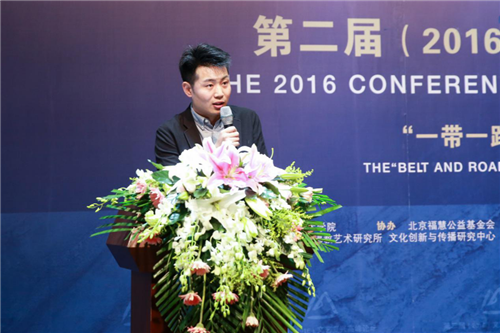
图2 中国人大学佛教艺术研究所特聘研究员邵学成博士发表演讲
Fig.2 The Specially-appointed Research Fellow of Institute of Buddhist Art Research of RUC, Dr. SHAW Xuecheng is giving a presentation
主旨演讲由邵学成博士主持,并先发表题为《从中国到中亚的转变——二战后日本研究阿富汗佛教美术史综述》的演讲,从学术史的角度系统介绍日本对阿富汗佛教美术的研究成果,并解释了日本对中亚佛教艺术展开研究的原因,以及这些研究对于学界的意义。
The keynote speech was hosted by Dr. SHAW Xuecheng, and he firstly gave a presentation called Transition from China to Central Asia: A Scholarly Review of the Japanese Researches on the Buddhist Art in Afghanistan after World War II (1945 - 2012), which was about the academic achievements of Japanese scholars, the reason why Japanese started to work on Central Asia Buddhist art and the valuable contributions made by them to the academic realm.
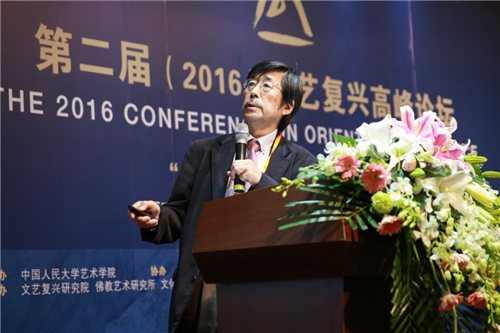
图3 龙谷大学宫治昭教授发表演讲
Fig.3 Professor Akira MIYAJI from Ryukoku University is giving a presentation
宫治昭教授发表题为《巴米扬石窟的调查研究史回顾》的演讲,呈现了日本对巴米扬遗址研究的整体成果,包括极为珍贵的在塔利班摧毁巴米扬大佛之前欧洲和日本学者对巴米扬的调查和研究成果,以及大佛被破坏后日本与联合国紧密合作开展保存和修复工作,并根据巴米扬壁画的C14检测结果,再次对该地区壁画年代学进行更准确的考证和分期。此外,还介绍了该地区出土的佛经写本及相关研究。
宫治昭教授在1969年至1978年间多次赴巴米扬开展实地考察,详细考证了欧美学者对巴米扬的探险史、考古学、美术史的研究成果并评论分析,并在巴米扬佛教图像学和年代学研究上取得了重大突破。
The topic of Professor Akira MIYAJI’s presentation was The History of Bāmiyān Studies: Look back on My Practice at Bāmiyān. The speech presented the Japanese academic achievements on Bamiyan, including the analyzing of investigations done by European and Japanese missions before Taliban destroyed Bamiyan Buddha, and the preservation and restoration work done by Japanese and UN after Bamiyan was destroyed. What’s more, according to the results of C14 test on Bamiyan murals, Japanese scholars reconfirmed a clearer and more precise chronology of the murals. Buddhist manuscripts excavated in this area were discussed as well.
During 1969 to 1978, professor MIYAJI had been on field investigating missions to Bamiyan for many times. He thoroughly researched and reviewed the expedition history, archaeological missions and art history research of European and American scholars, and made key breakthroughs on iconographical and chronological research of Bamiyan Buddhist Art.
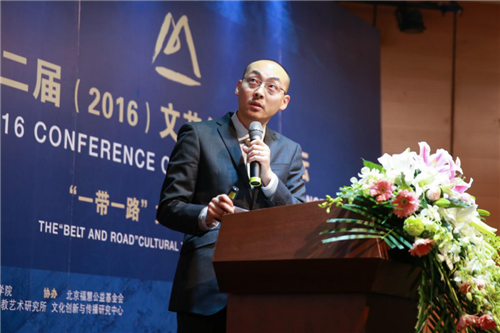
图4 龙谷大学岩井俊平副教授发表演讲
Fig.4 Associate Professor Shumpei IWAI from Ryukoku University is giving a presentation
岩井俊平演讲的题目为《巴米扬山谷寺院和石窟的年代学》,介绍了两个案例的年代学分析。第一个是2003年由日本国家文化财产研究所在巴米扬Ju-yi Shahr地区所发掘的寺院,并通过在底层基底中发现的部分抛光并由黑色线条装饰的陶器碎片确定该寺院建于公元6世纪左右。第二个是由Tarzi教授负责发掘的巴米扬主崖东侧寺院中有涅槃佛的A9廊道的重新断代。根据在涅槃佛前发现的5枚寄多罗金币至少流行至公元5世纪晚期,以及此寺院的年代及相关数据分析,确认该廊道的年代应晚于Tarzi教授所推断的晚期。
The topic of Associate Professor Shumpei IWAI’s presentation was Date of the Bamiyan Caves and the Ground-based Temples. He introduced two cases of chronological study. One case is a ground-based structure which is located in Ju-yi Shahr area excavated by National Research Institute for Cultural Properties, Japan (NRICP). A pottery sherd partly polished and painted with black lines from the bottom layer of the platform indicated the date of the structure was around 6th century CE. The other case is on reconfirming the date of gallery A9 in the ground-based temple in front of the east side of the main cliff excavated by Prof. Tarzi. As five gold dinars of Kidara excavated from a bench-like platform for Buddha statues in front of parinirvana Buddha and some numismatists assume that this type of dinar had continued to be struck until the late 5th century at the earliest. According to the data and the date of other Buddhist temples, the gallery A9 with parinirvana Buddha might belong to the period later than what professor Tarzi reported as late 4th century CE.
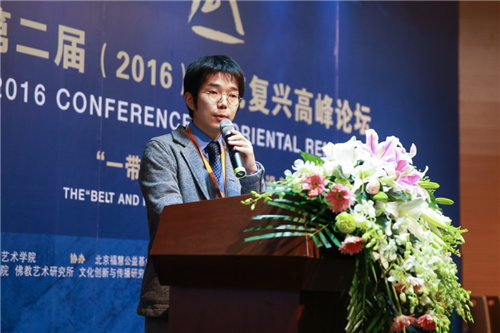
图5 京都大学内记理助教授发表演讲
Fig.5 Assistant Professor Satoshi NAIKI from Kyoto University is giving a presentation
内记理助教授发表了题为《关于四个犍陀罗铭文雕刻佛像的年代学》的演讲。介绍了在犍陀罗地区发现的四尊年代顺序一直存在争议的带有年代铭文的雕像,分别是:1)斯卡拉赫·特里的诃利帝母立像;2)巴拉杜·特里的立佛;3)莫玛内·特里的禅定佛;4)洛里延·唐盖的立佛。根据考古资料和风格学,内记博士找到了雕像的风格与其所处时期有对应关系,并结合对阿泽斯纪年的最新研究成果以及其在印度西北部出土的大多数铭文资料,最终确定这四尊雕像的年代依次为公元132/3, 237/8, 242/3, 271/2年。
Assistant Professor Satoshi NAIKI gave a presentation on Four Gandhāran Sculptures with Inscriptions Including Dates. He introduced four Gandhara statutes:1) a standing Hāritī statue found at Skārah Dherī, 2) a standing Buddha statue found at Pālātū Dherī, 3) a “meditating Buddha in Indrasāra cave” sculpture found at Mamāne Dherī, and 4) a standing Buddha statue found at Loriyan Tangai, which are considered to have controversial dates. According to archaeological data and stylistics research, Dr. NAIKI discovered it is possible to assign these sculptures to particular periods, by calculating these dates with the Azes era, these inscribed sculptures can be dated to 132/3, 237/8, 242/3, 271/2 CE respectively.
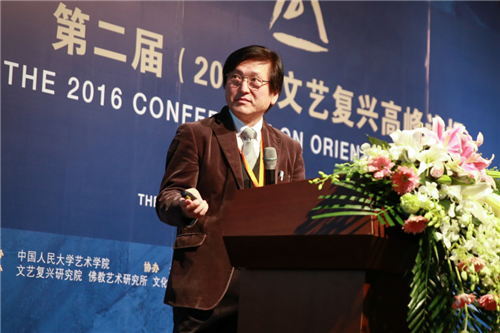
图6 东京艺术大学井上隆史教授发表演讲
Fig.6 Professor Takashi INOUE from Tokyo University of the Arts is giving a presentation
井上隆史教授发表了题为《失去的阿富汗遗产——复原巴米扬东大佛天井壁画“翱翔天空的太阳神”的经纬》的演讲,展示了东京艺术大学对此天井壁画复原的成果和展览视频,并介绍了复原所使用的“克隆再生”技术,此技术是高精度数字技术与传统修复技术的结合,旨在复原失去的丝路壁画,并向丝路沿线国家传播此技术,并向破坏文化遗产的恐怖行为提出抗议。此外还介绍了日本的巴米扬和平博物馆的构想和设计,博物馆功能包括巴米扬·数字档案、克隆壁画博物馆和8K影院三个部分。
Professor Takashi INOUE gave a presentation on The Lost Cultural Heritage of Afghanistan: The Challenge of Reproducing the Mural Painting on the Ceiling above the Head of the East Great Buddha Niche of Bamiyan. He displayed the recovered mural made by Tokyo University of the Arts and the videos of the exhibition, and gave an introduction on the “Clone Regeneration” technique used to recover the mural, which is a combination of high precision techniques and traditional restoration techniques, aiming at representing the lost murals along the Silk Road, providing the technique to Silk Road countries and protesting terrorism. Moreover, a museum symbolizing peace has been designed by Japanese and to be constructed in Bamiyan. The museum has three functions: save digital archives on Bamiyan, display murals reproduced by “Clone Regenration” technique, and an 8K cinema.
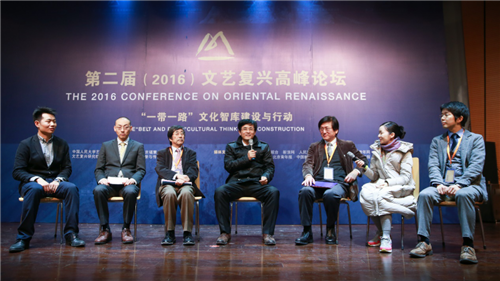
图7 讨论与问答(左起: 邵学成、岩井俊平、宫治昭、丁方、井上隆史、李艳梅、内记理)
Fig.7 Discussion and Q&A (from left, SHAW Xuecheng, Shumpei IWAI, Akira MIYAJI, DING Fang, Takishi INOUE, LI Yanmei, Satoshi NAIKI)
现场听众和专家进行了问答互动,包括“克隆复原”壁画的技术流程、材料研究,巴米扬壁画中所体现出了多元宗教文化,复原对象的选择标准和建议,以及学者们投身巴米扬研究的原因和动力等。
After the keynote speech, the audiences and experts carried on a Q&A interaction about the technical procedure of “Clone Regeneration”, material research, multi-religions embodied in Bamiyan murals, standards and suggestions on selecting cultural heritages to recover and the reasons and motivations that drive experts to devote themselves to Bamiyan research.
此次论坛是国内首个以日本专家对阿富汗的研究成果为核心的论坛,并基本梳理了外国学者当下对阿富汗的文化研究以及考古进展,全面评述了以往国外对阿富汗地区文化的特征研究,这对我国“一带一路”建设中必然面对的地方性文化特征提供了良好的范式模本,也为日后我国进入这一地区进行文化研究奠定了坚实的基础。
This forum is the very first one that focus on Japanese academic achievements on Afghanistan in China, which basically combed through the recent cultural researches and archaeological progressions of foreign experts, comprehensively reviewed the researches done by foreign experts on Afghanistan cultural characteristics. It not only provided a good model on how to understand local cultural identities for the boost of “The Belt and Road” Initiative, but also laid a solid foundation for our future studies in this region.
(中国人民大学艺术学院供稿 Contributed by School of Art,RUC)